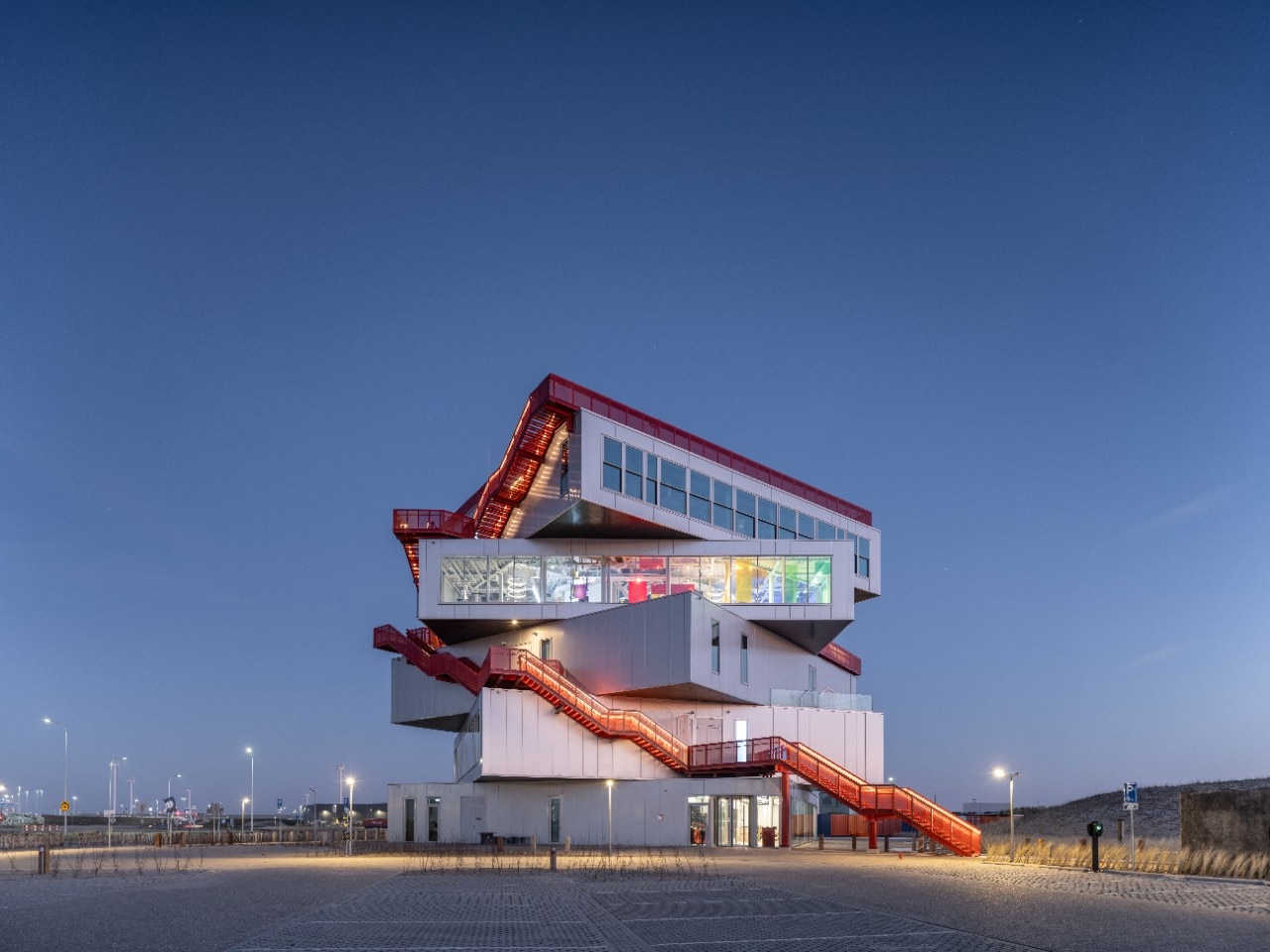Driving down the A20 highway, which leads from Rotterdam to its port—the most important in Europe—the passing landscape is unrelenting. Sparse vegetation, smokestacks spewing enormous clouds of smoke, low and elongated buildings blending with the containers in a jagged and monotonous scenery.
Then, suddenly, about forty minutes into the journey from the city, after a long curve, a small white tower with red outlines appears, standing alone on the flat expanse, separated from the beach and the ocean by dunes. A recently updated sign reads Portlantis.
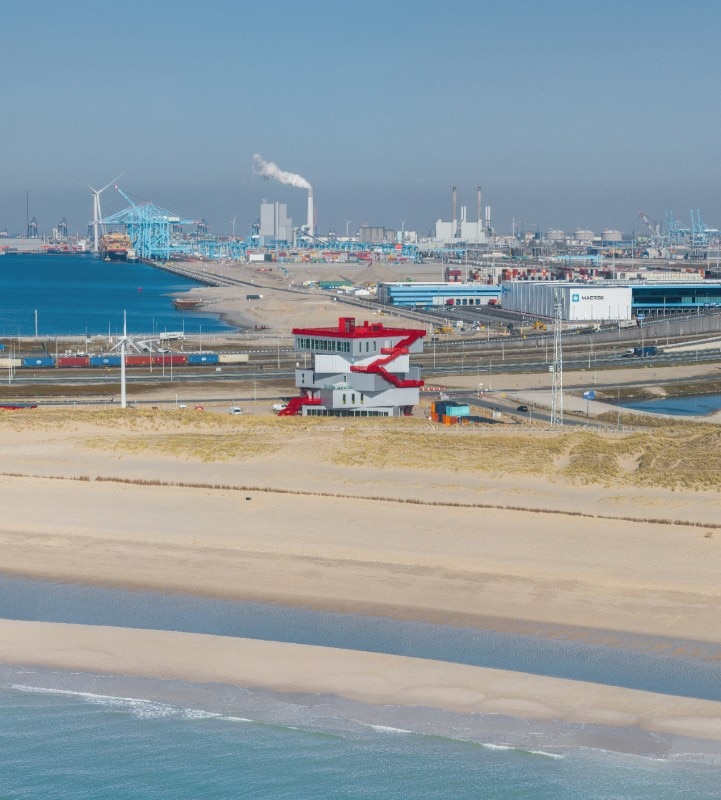
The relationship between the Netherlands and experience centers is a long-standing love story. FutureLand, the previous center for the Port of Rotterdam, was initially a temporary solution, built on Maasvlakte 2—2,000 hectares of land reclaimed from the sea. It was supposed to last five years. Instead, it remained open for 16, closing just a few days ago and passing the torch to Portlantis.
A “Cute” Vision for the Port
“I used to bike here and walk on the gigantic infrastructure,” recalls Winy Maas, guest editor of Domus in 2019 and co-founder of MVRDV. “I found it impressive,” he says, adding that the “landscape of boxes” fascinates him because it is the exact opposite of what one expects from the Netherlands—a land of “cuteness.” And cuteness is the key to Portlantis’s design: a cute building standing in an industrial setting so raw and straightforward that it feels almost unsettling.
The container, an emblematic structure of the port landscape, is reinterpreted in MVRDV’s design as a stack of white boxes, rotated relative to one another, creating an asymmetrical effect when viewed from the parking lot or the road. However, from above, they form a star. Surrounding the structure is a red staircase, reminiscent of the yellow one from Haus 1 in Berlin—this time with 134 steps.
An Experience Center for a Changing Port
Aligned with the port’s sustainability goals, Portlantis is built with circular economy principles in mind. Easily dismantled, it is made from reusable materials and lacks concrete foundations. A wind turbine powers the building, generating 30% more energy than it consumes, making it energy-positive.

Inside, Portlantis has the shape of a narrow and wide doughnut; it’s a cute building, not a large one—about half the size of the renowned Depot Boijmans that MVRDV designed in Rotterdam. Each floor covers less than 600 square meters, with a total volume of 12,500 cubic meters. Its central atrium, occupied mostly by a table with a digital map illustrating the evolution of the Port of Rotterdam, soars over 20 meters to the roof. This vertical void houses suspended installations, forming the heart of Portlantis. Staircases line the inner walls, leading visitors through different exhibition floors, showcasing the port’s past, present, and future through a mix of media, including augmented reality.
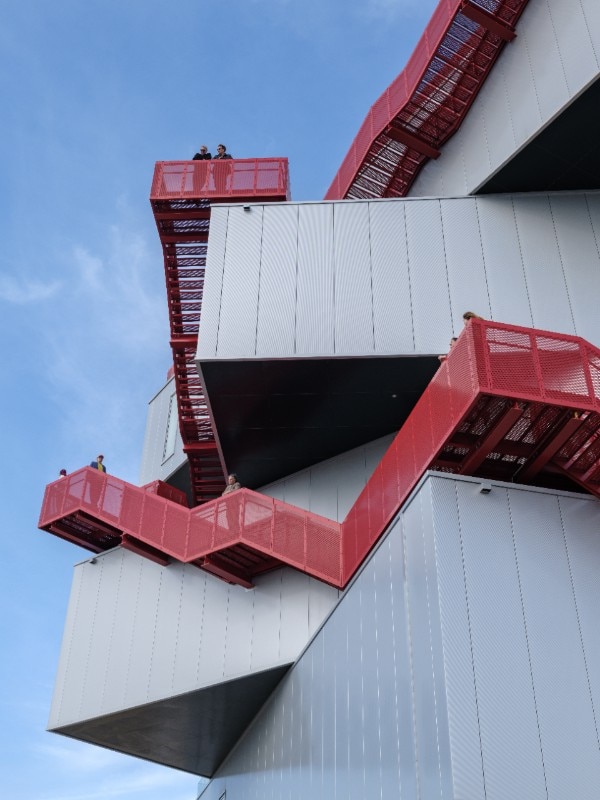
Just like in the port itself, the building’s structure exposes its infrastructure—its functional components are visible and transparent. A long yellow pipe runs through the space, reminiscent of the ventilation system in Van den Broek & Bakema’s central library—nicknamed “the Pompidou of central Rotterdam”—which can be seen framed within the large window of the Markthal, the market-residential complex MVRDV designed in the city center.
Each floor of Portlantis features large windows offering panoramic views of the port or framing the sunset, thanks to the staggered alignment of the levels. Visitors can see the dunes and sea, massive anchored ships, towering cranes, endless rows of containers, and the facilities where goods are assembled.
I used to bike here and walk on the gigantic infrastructure. I found it impressive: the landscape of boxes fascinates me because it is the exact opposite of what one expects from the Netherlands
Winy Maas

A competition rooted in storytelling
Of all the proposed designs, MVRDV’s was the only one developed vertically, Winy Maas explains to Domus as we ascend the stairs to the expansive rooftop terrace, offering sweeping views of the surroundings.
The competition process itself was unusual: the port first hired the design studio Kossmanndejong—experts in storytelling and exhibition design—to define the content and displays for the new experience center that would replace FutureLand. Only afterward did they seek an architectural firm, first through a concept competition and then through a shortlist of five finalists, who presented full-fledged projects.
MVRDV’s building provides the ideal stage for these exhibitions, embedding itself in the rich tradition of Dutch experience centers. “They are something I really like,” says Maas, noting that they reflect not only Dutch culture but also the country’s legal framework, which requires entities like the port to communicate their operations to the public.
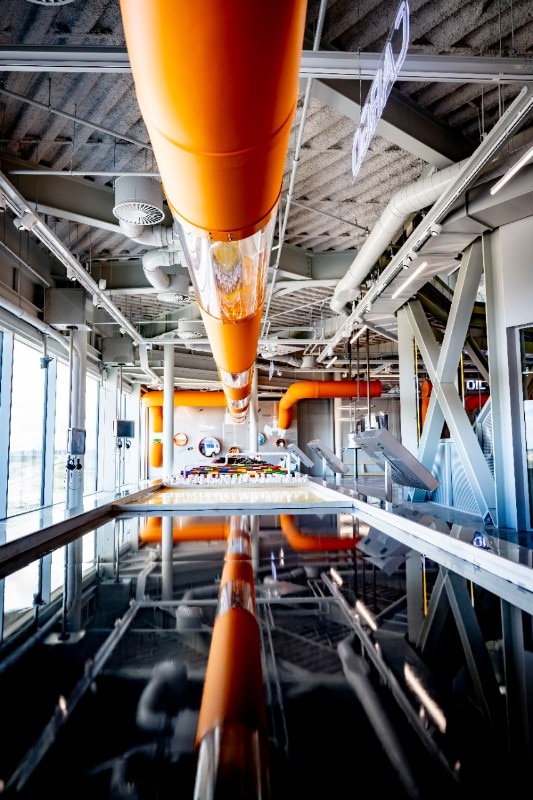
The port is in transition
Portlantis was conceived during the COVID-19 pandemic and is now opening after roughly two years of construction. In Rotterdam, massive floating red buoys announce the opening, and posters for the inauguration are everywhere. The center is expected to draw 150,000 visitors annually.
The port is undergoing a major transformation—not only due to persistent rumors about reclaiming more land to relocate the heavily trafficked Schiphol Airport but also because of its transition toward sustainability. Rotterdam’s port is aiming to become greener, cleaner, and fossil fuel-free by 2050. Currently, fossil fuels supply 50% of the energy demand. At the same time, the port is constantly seeking new talent and workforce—telling its story is essential.
“Transport is changing,” says Winy Maas. The port, he explains, is a paradox—between import and export, between growth and stability.
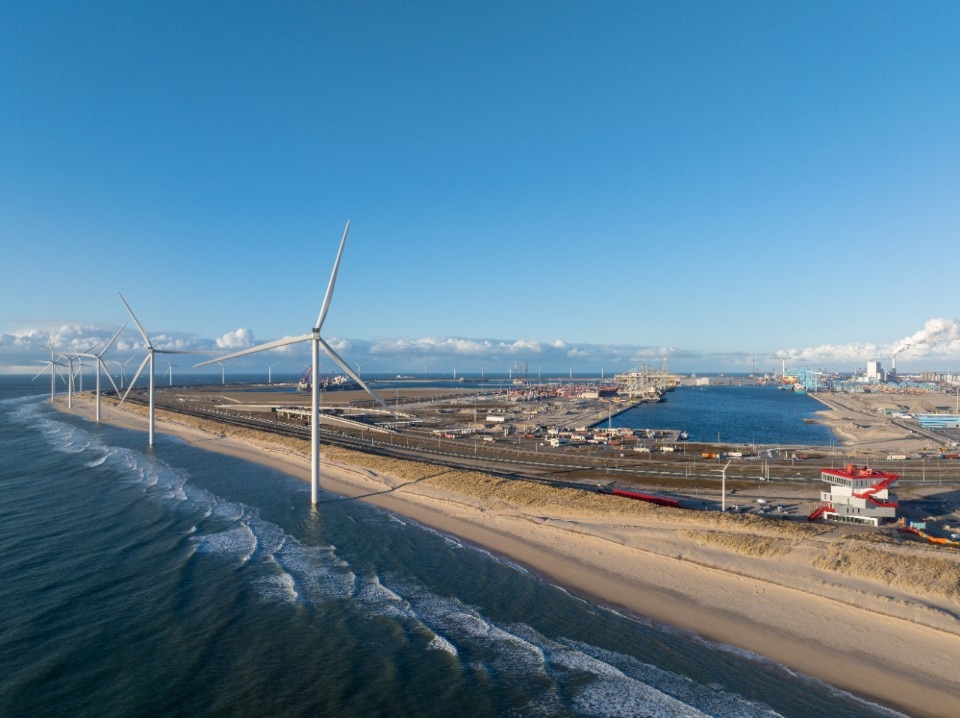
A grand paradox of modern life
But not only that. It is a paradox because just a short distance away, beaches attract large summer crowds, thanks to a metro connection. It is a paradox because certain bird species thrive here, drawn by the area’s low human presence. And, most significantly, the port embodies the contradiction in which we all live: we champion local, farm-to-table products and cut meat from our diets due to its environmental impact, yet at the second floor of the museum, a video inside a pseudo-container shows just how many of our daily essentials would be impossible without the port.
“Without us, you only have each other” is the unsettling tagline that appears at the end of the video.
Nearby, an electric bike is dismantled and suspended in midair, its main components displayed separately, revealing their origins. Visitors learn that the individual parts of an e-bike—an icon of sustainability—have likely traveled more miles inside a container than they ever will on the road. “The world is a very complicated network of things that shape our daily lives.” We might choose to ignore it, but the port remains an essential—and paradoxical—part of our existence.
Opening image: Mvrdv, Portlantis, Port of Rotterdam, Rotterdam, Netherlands. Photo Ossip van Duivenbode


